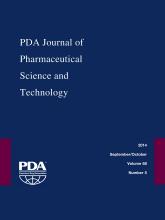Abstract
Environmental monitoring represents an integral part of the microbiological quality control system of a pharmaceutical manufacturing operation. However, guidance documents differ regarding recommendation of a procedure, particularly regarding incubation time, incubation temperature, or nutrient media. Because of these discrepancies, many manufacturers decide for a particular environmental monitoring sample incubation strategy and support this decision with validation data. Such validations are typically laboratory-based in vitro studies, meaning that these are based on comparing incubation conditions and nutrient media through use of cultured microorganisms. An informal survey of the results of these in vitro studies performed at Novartis or European manufacturing sites of different pharmaceutical companies highlighted that no consensus regarding the optimal incubation conditions for microbial recovery existed. To address this question differently, we collected a significant amount of samples directly from air, inanimate surfaces, and personnel in pharmaceutical production and packaging rooms during manufacturing operation (in situ study). Samples were incubated under different conditions suggested in regulatory guidelines, and recovery of total aerobic microorganisms as well as moulds was assessed. We found the highest recovery of total aerobic count from areas with personnel flow using a general microbiological growth medium incubated at 30–35 °C. The highest recovery of moulds was obtained with mycological medium incubated at 20–25 °C. Single-plate strategies (two-temperature incubation or an intermediate incubation temperature of 25–30 °C) also yielded reasonable recovery of total aerobic count and moulds. However, recovery of moulds was found to be highly inefficient at 30–35 °C compared to lower incubation temperatures. This deficiency could not be rectified by subsequent incubation at 20–25 °C. A laboratory-based in vitro study performed in parallel was inconclusive. We consider our results potentially conferrable to other pharmaceutical manufacturing sites in moderate climate zones and believe that these should represent a valuable reference for definition of the incubation strategy of microbiological environmental monitoring samples.
LAY ABSTRACT: Microbiological environmental monitoring confirms that pharmaceutical cleanrooms are in an appropriate hygienic condition for manufacturing of drug products. Guidance documents from different health authorities or expert groups differ regarding recommendation of the applied incubation time, incubation temperature, or nutrient media. Therefore, many pharmaceutical manufacturers perform studies that aim to identify the optimal incubation setup for environmental monitoring samples. An informal survey of the results of such studies, which had been performed at Novartis or European manufacturing sites of different pharmaceutical companies, highlighted no consensus regarding the optimal incubation conditions for microbial recovery. All these studies had been conducted in the laboratory using selections of cultured microbial strains. We tried to solve this disagreement by collecting a significant amount of real environmental monitoring samples directly from the environment in pharmaceutical production and packaging rooms during manufacturing operation. These samples were then incubated under different conditions suggested in the regulatory guidelines. We believe that the results of our study are more meaningful than laboratory-based experiments because we used environmental samples with microorganisms directly isolated from the manufacturing area. Therefore, we believe that our results should represent a valuable reference for definition of the incubation strategy of microbiological environmental monitoring samples.
- Environmental monitoring
- Incubation conditions
- Incubation temperature
- Nutrient media
- Microbiology
- Cleanroom
- © PDA, Inc. 2014
PDA members receive access to all articles published in the current year and previous volume year. Institutional subscribers received access to all content. Log in below to receive access to this article if you are either of these.
If you are neither or you are a PDA member trying to access an article outside of your membership license, then you must purchase access to this article (below). If you do not have a username or password for JPST, you will be required to create an account prior to purchasing.
Full issue PDFs are for PDA members only.
Note to pda.org users
The PDA and PDA bookstore websites (www.pda.org and www.pda.org/bookstore) are separate websites from the PDA JPST website. When you first join PDA, your initial UserID and Password are sent to HighWirePress to create your PDA JPST account. Subsequent UserrID and Password changes required at the PDA websites will not pass on to PDA JPST and vice versa. If you forget your PDA JPST UserID and/or Password, you can request help to retrieve UserID and reset Password below.






